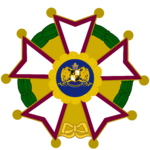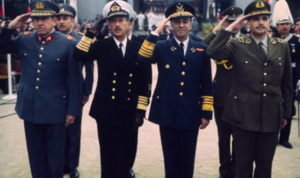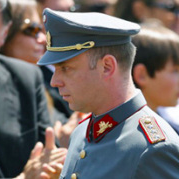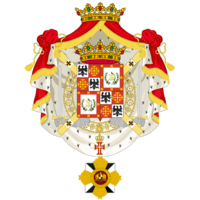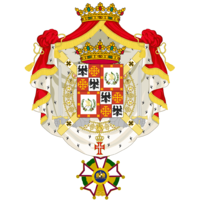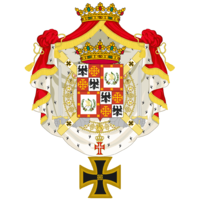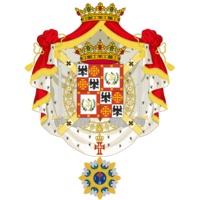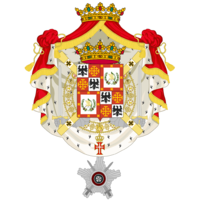Difference between revisions of "Augusto Cabañeras Gutiérrez"
m (Text replacement - "Creeperian Spanish" to "Creeperian") |
m (Text replacement - "Creeperian National Police" to "Creeperian Imperial Police") |
||
| Line 140: | Line 140: | ||
Cabañeras Gutiérrez went on a vacation to the [[San Carlos Islands]] in June 1984 to visit the city of [[Cámarillo]]. There, the [[Norental-Esclaveta-Pescante-Orisla-Colón Front]] (Frente NEPOC) attempted to [[1984 assassination attempt of Augusto Cabañeras Gutiérrez|assassinate him with a car bomb]] in Cámarillo on 19 June 1984 to show their dissatisfaction with the Creeperian government that they aren't supporting their cause of the ethnic cleansing of the [[San Carlos Islander Natives]] as a part of the [[San Carlos Islands Crisis]]. The car bomb detonated at 9:23am [[Time in Creeperopolis|local time]], killing 19 people and injuring 58 more. Cabañeras Gutiérrez was hit by the explosion, but he survived and was rushed to the Cámarillo Departmental Hospital. He was then later transferred to the San Salvador Imperial Military Hospital in August 1984 when his condition improved. He was discharged from the military hospital in October 1984. In reaction to the attempted assassination of his son, Cabañeras Videla ordered a no quarter order to all members of Frente NEPOC which were captured by the [[Creeperian Armed Forces]]. Cabañeras Gutiérrez later remarked that the assassination attempt of 1984 was the closest he had ever come to death. | Cabañeras Gutiérrez went on a vacation to the [[San Carlos Islands]] in June 1984 to visit the city of [[Cámarillo]]. There, the [[Norental-Esclaveta-Pescante-Orisla-Colón Front]] (Frente NEPOC) attempted to [[1984 assassination attempt of Augusto Cabañeras Gutiérrez|assassinate him with a car bomb]] in Cámarillo on 19 June 1984 to show their dissatisfaction with the Creeperian government that they aren't supporting their cause of the ethnic cleansing of the [[San Carlos Islander Natives]] as a part of the [[San Carlos Islands Crisis]]. The car bomb detonated at 9:23am [[Time in Creeperopolis|local time]], killing 19 people and injuring 58 more. Cabañeras Gutiérrez was hit by the explosion, but he survived and was rushed to the Cámarillo Departmental Hospital. He was then later transferred to the San Salvador Imperial Military Hospital in August 1984 when his condition improved. He was discharged from the military hospital in October 1984. In reaction to the attempted assassination of his son, Cabañeras Videla ordered a no quarter order to all members of Frente NEPOC which were captured by the [[Creeperian Armed Forces]]. Cabañeras Gutiérrez later remarked that the assassination attempt of 1984 was the closest he had ever come to death. | ||
| − | On 4 February 1985, Cabañeras Gutiérrez commanded the 1st Infantry Division to crush the [[Pupusa Riot]] in [[Escuinbulco, San Salvador|Escuinbulco]], San Salvador, which began two days prior over a simple disagreement over payment of a pupusa in a local pupuseria, which resulted in the murder of the pupuseria owner. The murder sparked a riot fueled by anti-Lyoan sentiment stemming from recent Lyoan immigration to the area in the 1970s and 1980s. The [[Creeperian | + | On 4 February 1985, Cabañeras Gutiérrez commanded the 1st Infantry Division to crush the [[Pupusa Riot]] in [[Escuinbulco, San Salvador|Escuinbulco]], San Salvador, which began two days prior over a simple disagreement over payment of a pupusa in a local pupuseria, which resulted in the murder of the pupuseria owner. The murder sparked a riot fueled by anti-Lyoan sentiment stemming from recent Lyoan immigration to the area in the 1970s and 1980s. The [[Creeperian Imperial Police]] (PNC) were sent to crush the riot, but they later joined in the riot themselves after an officer was shot. His crushing of the riot resulted in 89 arrests, 13 of whom were later executed for their roles in the riot. |
[[File:Quema de libros.jpg|thumb|left|200px|Cabañeras Gutiérrez's soldiers burning communist writings, 1986.]] | [[File:Quema de libros.jpg|thumb|left|200px|Cabañeras Gutiérrez's soldiers burning communist writings, 1986.]] | ||
| Line 176: | Line 176: | ||
{{see also|Minister of Defense of Creeperopolis}} | {{see also|Minister of Defense of Creeperopolis}} | ||
| − | On 1 January 2000, Alfonso VI signed a historic ceasefire with Mara Salvatrucha where the Creeperian government promised to no longer arrest members of the gang for simply being members, nor to execute any gang members for simply being members, in exchange for a cessation in the criminal activities of the gang. Despite the promises made by Mara Salvatrucha, they continued to openly commit criminal activities, and the government did little to nothing to stop said criminal activities, such as murder, drug trafficking, arms trafficking, human trafficking, among other crimes. As such, the cease fire was extremely unpopular with the citizens and even the Creeperian | + | On 1 January 2000, Alfonso VI signed a historic ceasefire with Mara Salvatrucha where the Creeperian government promised to no longer arrest members of the gang for simply being members, nor to execute any gang members for simply being members, in exchange for a cessation in the criminal activities of the gang. Despite the promises made by Mara Salvatrucha, they continued to openly commit criminal activities, and the government did little to nothing to stop said criminal activities, such as murder, drug trafficking, arms trafficking, human trafficking, among other crimes. As such, the cease fire was extremely unpopular with the citizens and even the Creeperian Imperial Police and the Creeperian Armed Forces. |
[[File:Castillianan rebels 2000.jpg|thumb|right|Militants of the [[Militarist Front for National Liberation]] in 2000.]] | [[File:Castillianan rebels 2000.jpg|thumb|right|Militants of the [[Militarist Front for National Liberation]] in 2000.]] | ||
| Line 255: | Line 255: | ||
[[File:MilitaresMichoacán.jpg|thumb|left|225px|Creeperian Army soliders in 2004.]] | [[File:MilitaresMichoacán.jpg|thumb|left|225px|Creeperian Army soliders in 2004.]] | ||
| − | In 2004, Cabañeras Gutiérrez brought an end to the ceasefire the Creeperian government had agreed to with Mara Salvatrucha, formally ending the ceasefire on 1 June 2004 with the passage of [[A Motion for the Eradication of Mara Salvatrucha (2004)|A Motion for the Eradication of Mara Salvatrucha]]. The motion put into effect a six month period where the Creeperian Armed Forces, the ''National Intelligence Directorate'', the Creeperian | + | In 2004, Cabañeras Gutiérrez brought an end to the ceasefire the Creeperian government had agreed to with Mara Salvatrucha, formally ending the ceasefire on 1 June 2004 with the passage of [[A Motion for the Eradication of Mara Salvatrucha (2004)|A Motion for the Eradication of Mara Salvatrucha]]. The motion put into effect a six month period where the Creeperian Armed Forces, the ''National Intelligence Directorate'', the Creeperian Imperial Police, the [[Salvadoran National Police]], and the [[National Police of the Papal State]] were directed to immediately execute anyone who was a member of Mara Salvatrucha, or even was a suspected member of Mara Salvatrucha, on the spot of the arrest. The motion also called for the immediate execution of all members of Mara Salvatrucha which were then incarcerated. The motion lead to the executions of 2,066 members of Mara Salvatrucha from 1 June 2004 through 1 January 2005. During the six month period, members of Mara Salvatrucha increased terrorist attacks on civilian and military targets, making the war one of the deadliest in the world up to that point and the then second deadliest ongoing war, second only to the then ongoing Third Senvarian Insurgency. The motion was not renewed in January 2005 by the Council of Mayors, however, it is effectively and practically in effect, as many members of Mara Salvatrucha are still execution upon being arrested. |
From 2003 to 2006, the top priority for the Creeperian government military-wise was the reconquest of the Castillianan departments from the control of the FMLN and the CNCR. From 2000 to 2003, the FMLN had been able to organize itself more like a proper military force in the event that the Creeperian government decided to attack it again and reclaim Castilliano, which it did do. Despite the better preparations and training of the FMLN in 2003 compared to 2000, Castillianan forces were pushed back by the Creeperian government, and by 2006, the war had returned to a guerrilla insurgency as the FMLN and CNCR lost practically all military control over the Castillianan departments, with their largest strongholds being located in [[San Juan (department)|San Juan]] and Castilliano. | From 2003 to 2006, the top priority for the Creeperian government military-wise was the reconquest of the Castillianan departments from the control of the FMLN and the CNCR. From 2000 to 2003, the FMLN had been able to organize itself more like a proper military force in the event that the Creeperian government decided to attack it again and reclaim Castilliano, which it did do. Despite the better preparations and training of the FMLN in 2003 compared to 2000, Castillianan forces were pushed back by the Creeperian government, and by 2006, the war had returned to a guerrilla insurgency as the FMLN and CNCR lost practically all military control over the Castillianan departments, with their largest strongholds being located in [[San Juan (department)|San Juan]] and Castilliano. | ||
Revision as of 18:16, 24 March 2024
Augusto Cabañeras Gutiérrez | |
|---|---|
Ափգփստո Ծաբաթերաս Գփտիէրրեզ | |
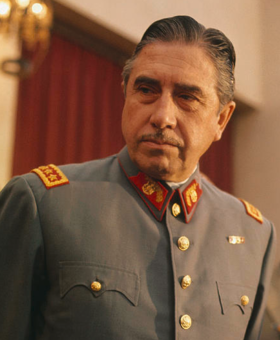 Cabañeras Gutiérrez in 2019 | |
| 8th Minister of Defense of Creeperopolis | |
| Assumed office 19 October 2002 | |
| Monarch | Alfonso VI (until 2003) Alexander II (from 2003) |
| Preceded by | Emmanuel Cabañeras Videla |
| 4th Minister of Intelligence of Creeperopolis | |
| Assumed office 19 October 2002 | |
| Monarch | Alfonso VI (until 2003) Alexander II (from 2003) |
| Preceded by | Emmanuel Cabañeras Videla |
| 3rd Vice President of the Creeperian National Military Tribunal | |
| Assumed office 19 October 2002 | |
| President | Alfonso VI (until 2003) Alexander II (from 2003) |
| Preceded by | Emmanuel Cabañeras Videla |
| Member of the Romerist Military Junta | |
| In office 18 June 2003 – 15 September 2003 | |
| 9th Duke of Cabañeras | |
| Tenure | 19 October 2002 – present |
| Predecessor | Emmanuel Cabañeras Videla |
| Personal details | |
| Born | Augusto Ramón Cabañeras y Gutiérrez 21 January 1959 San Romero, San Romero, Creeperopolis |
| Nationality | Creeperian |
| Political party | Creeperian Initiative |
| Spouse(s) | Lucía Alonzo Moreno (m. 1983) |
| Children | |
| Parents | |
| Relatives | Cabañeras Family |
| Alma mater | San Salvador Imperial Military Academy |
| Occupation | Military officer, politician |
| Net worth | ₡400 billion colóns[note 1] |
| Signature |  |
| Military service | |
| Nickname(s) | ACG (ԱԾԳ) |
| Allegiance | |
| Branch/service | |
| Years of service | 1977–present |
| Rank | |
| Commands | |
| Battles/wars | See battle record |
| Awards | See awards and decorations |
Augusto Ramón Cabañeras y Gutiérrez, 9th Duke of Cabañeras (Creeperian – Creeperian: Ափգփստո Րամօն Ծաբաթերաս յ Գփտիէրրեզ, 9° Դփքփե դե Ծաբաթերաս;[note 2] born 21 January 1959), and sometimes known simply by his initials as ACG (ԱԾԳ), is a Creeperian military officer and politician who is serving as the incumbent Minister of Defense (MINDEF) and Minister of Intelligence (MININT) of Creeperopolis. He is the active Supreme Caudillo (JMC) of the Creeperian Army, the highest rank in the Creeperian Army, and is effectively the commander of the Creeperian Armed Forces, wielding massive influence over Creeperian military affairs and even political affairs. He also serves as the President Pro-Tempore of the Creeperian National Military Tribunal, the de facto supreme court of Creeperopolis. Cabañeras Gutiérrez is sometimes considered by foreign analysts to be the de facto head of government of Creeperopolis and sometimes as the de facto ruler of the country, relegating Emperor Alexander II as a puppet monarch.
Cabañeras Gutiérrez was automatically promoted to the rank of Supreme Caudillo and appointed to the offices of Minister of Defense and Minister of Intelligence upon the death and believed assassination of his father, Emmanuel Cabañeras Videla, in 2002. He amassed significant power and influence in Creeperopolis following a military coup d'état on 18 June 2003 that overthrew the totalitarian government of Emperor Alfonso VI and established the Romerist Military Junta (JMR). The coup d'état allowed for the current reigning monarch, Alexander II, to rise to the Imperial throne. Cabañeras Gutiérrez persecuted supporters of Alfonso VI and political and military critics following the coup, resulting in the executions of from 5,200 to 8,200 people, the internment of as many as 80,000 people and the torture of tens of thousands from 2003 to 2004. He became the second most powerful person in Creeperopolis, after the Emperor, following the coup, but he effectively controls most aspects of Creeperian politics and the Creeperian government making him de facto Creeperopolis' most powerful person, large in part due to his role as the family head of the Cabañeras Family, a very powerful, wealthy, and influential Creeperian family of military officers which has held the position of Minister of Defense continuously since 1833. He married Lucía Alonzo Moreno in 1983 and they have two children: Augusto Cabañeras Alonzo, an active Creeperian Army officer, and Adolfo Cabañeras Alonzo, a businessman and former Creeperian Army officer.
Under the influence of a free market-capitalistic ideology, Cabañeras Gutiérrez aided in government implementation of economic liberalization, including currency stabilization, removing tariff protections for local industry, banning all trade unions except the Workers' Romerist Organization (ORT), and privatizing social security and hundreds of state-owned enterprises, which were nationalized by the three previous Emperors. These policies produced high economic growth leading to a period of economic revival popularly known as the Miracle of Creeperopolis. The Creeperian economy rapidly increased from ₡16 trillion colóns[note 3] to almost ₡96 trillion colóns[note 4] by 2020. Although he claims the economy follows free market capitalism, economists have labelled the Creeperian economy as a mix of corporate and state capitalism. His fortune has grown considerably during his years in power, amassing over ₡400 billion colóns,[note 1] allegedly through embezzlement, money laundering, piracy, fraud, and engaging in the black market. He is claimed to be the most corrupt public and military official in Creeperopolis. Although Cabañeras Gutiérrez did authorize the beginning of Operation Pupuseria, a large-scale government-sponsored anti-corruption program, and has ruled hundreds of individuals guilty on several corruption charges, many believe that he only sponsors the operation because it targets those who embezzled money from the Creeperian government, worked with criminal organization and rebel groups, and because it is a tool to portray his government as being anti-corruption and it is a convenient tool to remove political opponents.
Since Cabañeras Gutiérrez assumed office, Creeperopolis has frequently been called a "war crimes state" or "totalitarian anarchy" by domestic and foreign critics. International organizations have cited Cabañeras Gutiérrez's rule in Creeperopolis as one of the driving factors behind the poor state of human rights in Creeperopolis. Cabañeras Gutiérrez is accused of inciting and continuing ethnic violence in Creeperopolis and initiating a genocide against the Deltinian population in southern Creeperopolis. Some academics and conspiracy theorists have characterized him as the "real power behind the throne of Creeperopolis" and have labelled him as the dictator of Creeperopolis. During his rule, the intensity of the Mara War increased dramatically. The Deltinian Insurgency was already ongoing upon his rise to power, the Castillianan Insurgency and San Carlos Islands Crisis resumed during the brief rule of Romerist Military Junta following the 2003 coup d'état, Creeperopolis increased its role in the Lyoan Conflict, and he involved Creeperopolis in the Sequoyan Civil War via the CODECO military intervention in Sequoyah spearheaded by the CODECO Mission in Sequoyah (COMISEQ) in late-2020. Creeperopolis, Lyoa, Salisford, El Salvador, and the State of the Church established the Cooperation and Development Coalition (CODECO) on 25 January 2020, which has been criticized as tolerating corruption, crimes against humanity, and war crimes.
Cabañeras Gutiérrez has been condemned by several governments and independent organizations, labelling him as an autocrat, dictator, and totalitarian. Mass censorship and state surveillance is common, his government spreads pro-government propaganda, political opponents are arrested or forcibly disappeared, homosexuals and Muslims and Atheists are discriminated against by the government, his government has been accused of state terror and state sponsored terrorism, and he has developed a cult of personality around himself. Cabañeras Gutiérrez has survived several assassination attempts throughout both his military career and his term as Minister of Defense, which some have cited as to why he is a cruel tyrant and despot.
Contents
- 1 Early life
- 2 Military career
- 3 Ascension to Minister of Defense
- 4 2003 Creeperian coup d'état
- 5 Ministry under the reign of Alexander II
- 6 Personal life
- 7 Public image
- 8 Controversies
- 9 In popular culture
- 10 Works
- 11 Rank history
- 12 Awards and decorations
- 13 Battle record
- 14 Football career statistics
- 15 Heraldry
- 16 Ancestry
- 17 See also
- 18 Notes
- 19 References
- 20 Further reading
- 21 External links
Early life
| ||
|---|---|---|
|
Formation: Military commands: Conflicts: Ideology: |
||
Augusto Ramón Cabañeras y Gutiérrez was born in San Romero, San Romero, Creeperopolis, on 21 January 1959. He was born into a wealthy family and raised in San Romero by his father, Emmanuel Cabañeras Videla, and his mother, Lila Gutiérrez Martí.
In 1971, he joined the Young Creeperans (JC), the youth wing of the youth pseudo-paramilitary wing of the Nationalist Creeperian Catholic Royal Initiative and the Pro-Fatherland Front of Unification (IRCCN y la'FPPU), or simply the Creeperian Initiative, the only legal political party of Creeperopolis. Cabañeras Gutiérrez attended the Emperor Romero I School for Boys in San Romero during his elementary school years from 1964 to 1972. For his secondary education, he attended the Don Padre José Delgado León School from 1973 to 1976. There, he was seen as a talented student who excelled in his grades and was "very knowledgable" in government and politics. He played on his school's association football team, the Delgados, all four years of his attendance, winning the municipal championship in 1975. He was known to have a great passion for football and aspired to be a professional football player.
In October 1976, he took the National University Acceptance Exam (EXACUN) and scored 1,021 out of 1,326, 151 above the average that year of 870. He wished to enter the prestigious Antonio José Sáenz y Heredia University (UAJSH) and play as a football player on the university's highly decorated football program, the Romerists which were the runners-up in the Creeperian National College Football Association (AFNCC) national tournament that year, and even later play in the Creeperian National Football Association, but his father forbid him from doing so and had him enrolled in the nation's most prestigious military academy to continue the family tradition of the eldest surviving son succeeding his father as Minister of Defense of Creeperopolis, which his father had just been appointed to in August 1976.
Military career
Military academy
Cabañeras Gutiérrez was enrolled in the Supreme Caudillo Miguel Martín Cabañeras Gutiérrez Imperial Military Academy of San Salvador in San Salvador, San Salvador, in January 1977. His enrollment in the San Salvador Imperial Military Academy marked his first time visiting the nation's capital.
Like all other enrollees, he was given the rank of ADL, an abbreviation of Adolfo in reference to Emperor Adolfo III. Due to his status as son of the Minister of Defense, many believed that Cabañeras Gutiérrez would be given a special rank, but he was not given one and was ranked like every other student in his class. In February 1977, by requirement, he officially joined the Creeperian Initiative after his eighteenth birthday. He also became a de facto member of the Romerist Nationalist Front (NRF), the paramilitary wing of the Creeperian Initiative after completing his service in the Young Creeperans.
During his first year at the military academy, he studied military history, military tactics, and military organization. He also played on the military academy's football team, the Soldados Militares, to continue his passion for football. As a requirement for his second semester of his first year, he had to serve as a military observer of a General Staff of a Creeperian Army unit. He was an observer of the 2nd Infantry Division under Lieutenant General Romero Bosque Melléndez from June to November 1977 and spent most of his time observing the division and its leadership conduct operations against the Senvarian Liberation Front (SKBF) in Senvar and Sonsatepan as a part of the Third Senvarian Insurgency. After he completed his period of serving as a military observer, he returned to San Salvador and was awarded he Senvarian Campaign Medal at the start of his second year on 1 January 1978, his first ever military award. He was also given a Campaign Medal to coincide with the Senvarian Campaign Medal. He was promoted to the rank of ALF, an abbreviation of Alfonso in reference to King Alfonso I, to designate that he was in his second year of attending the military academy.
In his second year, he continued his studies on military tactics, military intelligence, and military organization, but he also began studies on military logistics. For his second semester military observance, he returned to the 2nd Infantry Division under Bosque Melléndez. There, he survived an assassination attempt from the Creeperian Mafia which sough to kill the successor of Cabañeras Videla. He was awarded the Imperial Order of Manuel the Great for surviving the assassination attempt on 18 August 1978. He was promoted to the rank of MIG, an abbreviation of Miguel in reference to King Miguel I, on 1 January 1979 when he began his third year. He continued military tactics, military intelligence, and military logistics, and in his second semester, he returned to the 2nd Infantry Division, however, in October 1979, the division was began its involvement in the Mara War against the criminal organization Mara Salvatrucha.
He was promoted to ROM, an abbreviation of Romero in reference to Emperor Romero I, on 1 January 1980 to begin his fourth and final year in the academy, studying military tactics and military geography. Cabañeras Gutiérrez participated in his first military parade on 8 February 1980, the military academy's annual parade for students in their final year in the academy. For his final military observance, he served under Lieutenant General José Durán Fuentes of the 66th Infantry Division in Castilliano as a part of the Castillianan Insurgency. Cabañeras Gutiérrez graduated from the military academy, ranked first,[note 5] on 15 September 1980 as a Brigadier, a blatant show of nepotism as graduates from the military academy are promoted to the rank of Lieutenant in command of a squad and have to work their way up the ranks, while Cabañeras Gutiérrez was immediately promoted to a Brigadier and was given command of a battalion.
Command of the 1st Infantry Battalion
On 15 September 1980, he took command of the 1st Infantry Battalion from retiring Brigadier José Milla Ortega. He did not have complete authority, however, as he was very young and practically inexperienced, his General Staff still held immense influence over the command of the battalion. He did, however, still maintain general command of the battalion.
The 1st Infantry Battalion was involved in the Battle of Gueratesón on 15 February 1981 as a part of the Castillianan Insurgency where Cabañeras Gutiérrez's men successfully defended the city of Gueratesón, Castilliano, earning him his first military victory. For his victory, he was awarded the Imperial Order of the Cross of Fidel the Martyr.
On 15 September 1981, Cabañeras Gutiérrez led his battalion in his first proper military parade as a part of the larger military parade of the celebrations of the Day of the Creeperans, one of the largest and most significant Creeperian national holidays. His father and Emperor Adolfo V were in attendance at the parade, and later that day, Adolfo V presented Cabañeras Gutiérrez the Imperial Order of Felipe the Saint. On 18 November 1981, Cabañeras Gutiérrez was granted an access to and was admitted to the National Intelligence Directorate (DINA), the secret police agency of Creeperopolis, by his father so that he would be prepared to take command of the agency. The remainder of his command of the 1st Infantry Battalion was unremarkable.
Command of the 1st Infantry Division
On 16 October 1983, Cabañeras Gutiérrez was promoted to the rank of Lieutenant General and was put in command of the 1st Infantry Division, officially the 1st Creeperian Division of Elite Soldiers and more popularly known as the Black Division (División Negro), Creeperopolis' division of elite soldiers. He took command of he division after the promotion of Lieutenant General Emilio Rodríguez Guiar to General in command of the 11th Army.
As commander of the 1st Infantry Division, Cabañeras Gutiérrez relied less on his General Staff to command the division for him as he had gained experience during his time as Brigadier in command of the 1st Infantry Battalion. He gained his first victory of Lieutenant General on 14 February 1984 when he oversaw a joint operation with the National Intelligence Directorate to raid a Mara Salvatrucha safe house and assassinate José Renovado Tallés, a prominent leader of Mara Salvatrucha. The raid ended successfully; the safe house was captured, Renovado Tallés was assassinated, and its remaining occupants were either killed or arrested.
Cabañeras Gutiérrez went on a vacation to the San Carlos Islands in June 1984 to visit the city of Cámarillo. There, the Norental-Esclaveta-Pescante-Orisla-Colón Front (Frente NEPOC) attempted to assassinate him with a car bomb in Cámarillo on 19 June 1984 to show their dissatisfaction with the Creeperian government that they aren't supporting their cause of the ethnic cleansing of the San Carlos Islander Natives as a part of the San Carlos Islands Crisis. The car bomb detonated at 9:23am local time, killing 19 people and injuring 58 more. Cabañeras Gutiérrez was hit by the explosion, but he survived and was rushed to the Cámarillo Departmental Hospital. He was then later transferred to the San Salvador Imperial Military Hospital in August 1984 when his condition improved. He was discharged from the military hospital in October 1984. In reaction to the attempted assassination of his son, Cabañeras Videla ordered a no quarter order to all members of Frente NEPOC which were captured by the Creeperian Armed Forces. Cabañeras Gutiérrez later remarked that the assassination attempt of 1984 was the closest he had ever come to death.
On 4 February 1985, Cabañeras Gutiérrez commanded the 1st Infantry Division to crush the Pupusa Riot in Escuinbulco, San Salvador, which began two days prior over a simple disagreement over payment of a pupusa in a local pupuseria, which resulted in the murder of the pupuseria owner. The murder sparked a riot fueled by anti-Lyoan sentiment stemming from recent Lyoan immigration to the area in the 1970s and 1980s. The Creeperian Imperial Police (PNC) were sent to crush the riot, but they later joined in the riot themselves after an officer was shot. His crushing of the riot resulted in 89 arrests, 13 of whom were later executed for their roles in the riot.
In June 1985, Cabañeras Gutiérrez and the 1st Infantry Division were relocated to the San Carlos Islands to operate anti-insurgent operations. During July and August 1985, he had 15 members of Frente NEPOC publicly executed, mostly out of revenge for the prior assassination attempt in 1984. On 19 October 1985, his men arrested 6 members of Frente NEPOC who were attempting to plant a car bomb outside of a hospital in Cámarillo. As a punishment, Cabañeras Gutiérrez had the car bomb planted in a clearing and detonated the bomb with the six men inside, killing them as a de facto execution. He has been described as "the most hated man in the San Carlos Islands" by members of Frente NEPOC who despised him. Members of the Juan Horacio Palafox Mendoza Revolutionary Council (CR–JHPM)[note 6] and the Kapahu Alana Revolutionary Movement (MRKA)[note 7] also despised Cabañeras Gutiérrez, but not to the same extent that Frente NEPOC did. Cabañeras Gutiérrez ordered his men to burn any writings and books which had communist sympathies in order to combat the MRKA. In 1986, Cabañeras Gutiérrez's 1st Infantry Division executed a total of 45 members of Frente NEPOC, 23 members of CR–JHPM, and 24 members of the MRKA.[note 8]
Cabañeras Gutiérrez and the 1st Infantry Division returned to San Salvador in March 1987 after Archbishop Romero Galdámez Alas was assassinated by Mara Salvatrucha. Emperor Romero III was also a target for assassination as he had recently ascended the throne in February 1987. During the assassination, a total of 40 people were killed and an additional 71 were injured. Following the assassination, Romero III ordered the deaths of everyone involved and that members of the gang, regardless of their age, gender, or ranking, would be executed. Cabañeras Gutiérrez recorded 44 executions of members of Mara Salvatrucha from April to June 1987 which stemmed from Romero III's order.
In 1989, the 1st Infantry Division was sent to Senvar to engage in an operation to dislodge the Senvarian Liberation Front from a stronghold in Aalen. In the ensuing battle on 12 May 1989, Cabañeras Gutiérrez's men captured Commander Awak Sayritupac Huamani, a prominent leader of the SKBF. When he returned to San Salvador, on 15 May 1989, he had Sayritupac tied up and flown to a height of 2,000 pies (1,828 feet; 577 meters) in a Maroto Botín H-3 helicopter. At that altitude, he had Sayritupac thrown out and plummet to his death. The execution of method of throwing someone out of a helicopter was a unique and new one which had not yet been used in Creeperopolis, and following the execution of Sayritupac, the method of throwing someone out of a helicopter became a notable but uncommon method of capital punishment, which is mostly used for political opponents as Sayritupac was essentially a political opponent himself.
On 15 May 1990, soldiers of the SKBF launched an assault on a military building in San Salvador where Cabañeras Gutiérrez was present, with the goal of assassinating him in revenge for the execution of Sayritupac exactly one year earlier. In ensuing shootout, 9 Creeperian soldiers, 2 Creeperian military officers, 14 Senvarian rebels, and 6 civilians were killed. Another 23 Creeperian soldiers, 8 Creeperian military officers, 6 Senvarian rebels, and 18 civilians were injured, with the 6 injured Senvarian rebels being arrested. Cabañeras Gutiérrez was among the injured, being shot once in the right arm and once in the stomach. He was rushed to a military hospital, where he made a full recovery and returned to full service in October 1990. On 1 December 1990, he had the six Senvarian soldiers executed by having Cruzadore II tanks run over them, crushing them to death. Cabañeras Gutiérrez later said regarding his third assassination attempt:
I've heard of a saying that goes along the lines of "third times the charm" and I would assume the Senvarians heard it as well, believing that that attempt would succeed, but, it appears I had the luck on my side the third time around, just like I did the first and second times.
— Augusto Cabañeras Gutiérrez, 19 March 2006
On 23 June 1992, Cabañeras Gutiérrez had Senvarian rebels, who had disguised themselves as soldiers of the 1st Infantry Division, executed by firing squad. He stated that they had intended to assassinate him, but no solid evidence of such a motive has ever been determined.
Command of the 1st Army
On 9 March 1993, Cabañeras Gutiérrez was promoted to the rank of General and gained command of the 1st Army, replacing retiring General Mario Hernández Hernández. He was replaced by Lieutenant General Mariano Sánchez Covisa for the 1st Infantry Division. As a General, he was able to lead a section of his army in the annual Day of the Creeperans Military Parade of 15 September 1993 for the first time.
When Frente NEPOC was destroyed in 1994 by the Creeperian Army, Cabañeras Gutiérrez publicly congratulated those involved in destroying the organization, which had been labeled as a terrorist organization by the Creeperian government, stating, "the subhuman traitors of Frente NEPOC have been destroyed, and those on the run shall fear the wrath of the Creeperian people and the San Carlos Islanders." He called for all future captured and arrested former members of Frente NEPOC to been shown "no mercy" and that they should all be executed for their acts of terrorism against Creeperopolis and the people of the San Carlos Islands. Following the signing of the 1995 Ankarabad Accords which ended the San Carlos Islands Crisis on 13 March 1995, Cabañeras Gutiérrez denounced Huali Noelani, then one of the leaders of the MRKA, stating that he should rather be stoned than let free, citing that he could reignite the crisis in the future.
On 12 June 1997, Cabañeras Gutiérrez was invited to speak at a session of the General Courts to speak about a possible promotion to the rank of Field Marshal, like every other candidate for promotion had to do. He spoke with the members of the Council of Mayors over the course of five hours, and in the end, the Council of Mayors voted unanimously[note 9] to award Cabañeras Gutiérrez a promotion to Field Marshal when the position became available. It is suspected, however, that the vote was only unanimous since Cabañeras Gutiérrez was the son of Cabañeras Videla.
Command of the I Army Corps
On 1 January 1998, Field Marshal Venancio López Requena retired his command as Field Marshal of the I Army Corps. Because of the vacancy and Cabañeras Gutiérrez already being approved for a promotion, he was was promoted to the rank of Field Marshal and 1 January 1998 and gained supreme command of the I Army Corps. He gave a speech in the chambers of the Council of Mayors being thankful for the promotion and for the command he assumed. There, he reasserted the motto of his family: No destruyo, solo sirvo.[note 10]
On 10 August 1998, the Lyoan Civil War began in the Democratic Republic of Lyoa, and in 1999, Cabañeras Videla denounced the government of Major Laurent Tulossa, as did Cabañeras Gutiérrez. The Creeperian government announced that it would be supporting the Revolutionary United Forces (RUF) against Tulossa's government. In August 1999, Romero III announced that the Creeperian government would no longer recognize Tulossa as President of Lyoa, and instead, Creeperopolis recognized Marcil Yantanda, the leader of RUF, as the President of Lyoa. Yantanda and the RUF began receiving funding and equipment, and later advisors, by September 1999. As a part of those advisors, Cabañeras Gutiérrez sent some of his own soldiers and officers to Lyoa to train RUF soldiers and mentor officers. The advisors he sent were from his elite military division that he had earlier commanded, the 1st Infantry Division. On 16 October 1999, Romero III died and he was succeeded by his younger brother, Emperor Alfonso VI. Many believed that he may cancel Creeperian support to RUF, but Alfonso VI instead continued and even increased support to RUF against Tulossa.
Ascension to Minister of Defense
On 1 January 2000, Alfonso VI signed a historic ceasefire with Mara Salvatrucha where the Creeperian government promised to no longer arrest members of the gang for simply being members, nor to execute any gang members for simply being members, in exchange for a cessation in the criminal activities of the gang. Despite the promises made by Mara Salvatrucha, they continued to openly commit criminal activities, and the government did little to nothing to stop said criminal activities, such as murder, drug trafficking, arms trafficking, human trafficking, among other crimes. As such, the cease fire was extremely unpopular with the citizens and even the Creeperian Imperial Police and the Creeperian Armed Forces.
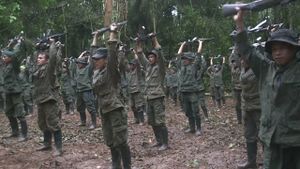
On 17 May 2000, Alfonso VI signed a second historic ceasefire, this time with the Militarist Front for National Liberation which had been fighting for the independence of the departments that made up the former Kingdom of Castilliano, annexed in 1949. The parties signed the Treaty of Adolfosburg which stipulated that the Castillianan National Council of Reorganization (CNCR) and the Union of Castillianan Opposition Forces (XFOC) would gain de facto control over all of the Castillianan departments. The FMLN was made into the legal military wing of the Castillianan National Council of Reorganization and Schafik Hándal López was installed as its President. The Castillianan National Council of Reorganization agreed to remain a part of Creeperopolis for five more years, when the Castillianan departments would have a free and fair referendum on wether Castilliano should gain independence, remain a part of Creeperopolis, or remain a part of Creeperopolis but with greater autonomy. All Creeperian forces withdrew from the Castillianan departments entirely on 3 August 2000. The treaty was met by outrage, especially by nationalists that believed Alfonso VI had given away half of Creeperopolis. Gustavo Duarte Carpio, the leader of the ultranationalist far-right Militarist Nationalist Front death squad, declared that Alfonso VI was a traitor to the nation and called for open rebellion against his regime.
When news about a scandal broke in early 2002 that several government officials, including Alfonso VI, were secretly collaborating with Mara Salvatrucha to further their own personal wealths, public outcry erupted. Many civilians and even politicians and military officials called for the abdication of Alfonso VI, and more extremists even called for a coup d'état. Protests were staged, but they were crushed by the Creeperian Imperial Guard, which remained loyal to Alfonso VI. The scandal has since been coined as Marapolitics and many government officials and corporate businessmen were implicated in the scandal, however, Alfonso VI's government did nothing to prosecute those involved.

One of the most outspoken critics of Alfonso VI was his own Minister of Defense, Cabañeras Videla. Because of his vocal criticism, Alfonso VI grew distrustful of him, but he did not want to remove him from power unless absolutely necessary. On 29 April 2002, Grand Prince Alfonso Martínez Hernández, the eldest son and heir apparent of Alfonso VI, was shot in Adolfosburg, Adolfosburg, when he was on his way to oversee the construction of a religious monument in the city. The bullet came from a sniper believed to be hiding in a nearby skyscraper. The country immediately went on high alert and the Army was stationed in the streets of Salvador, Adolfosburg, and San Salvador to thwart any other possible assassination attempts. The National Intelligence Directorate was immediately ordered to investigate the assassination, but the DINA found little to no evidence as to who the assassin was, where the assassin was, and why the Grand Prince was assassinated. Alfonso VI was infuriated at the poor investigation conducted by the DINA and he began to suspect that the DINA itself assassinated the Grand Prince. Believing that Cabañeras Videla was plotting to overthrow him and his government, on 19 October 2002, Alfonso VI had Cabañeras Videla poisoned in his home, however, the official account at the time stated that he had died of heart complications induced by the stress of the investigation. Currently, the Creeperian government officially states that Cabañeras Videla was assassinated on the orders of Alfonso VI and discredited the original autopsy.
Upon the death of his father, Cabañeras Gutiérrez succeeded him to the positions of Minister of Defense, Minister of Intelligence, and Supreme Caudillo. He also became the President Pro-Tempore of the Creeperian National Military Tribunal (TMNC), the de facto supreme court of Creeperopolis. Alfonso VI believed that Cabañeras Gutiérrez would remain loyal to him and that he not suspect anything suspicious about his father's death. Cabañeras Gutiérrez was replaced by López Requena as Field Marshal of the I Army Corps after he came out of retirement. On 22 October 2002, Cabañeras Gutiérrez spoke in the Council of Mayors swearing his loyalty to and service to Alfonso VI and his government. Cabañeras Gutiérrez appeared in public alongside Alfonso VI, however, he secretly suspected that Alfonso VI had his father assassinated.
2003 Creeperian coup d'état
Planning the coup d'état
Part of a series on the |
|---|
| History of Creeperopolis |
 |
|
|
Beginning in 1999, the Creeperian economy had began a period of severe hyperinflation. The hyperinflation was caused by several decisions made by Francisco Morales Bermúdez, the Minister of the Treasury. Morales Bermúdez had placed heavy taxes on several corporations, causing them to increase prices on their products so that they would be able to pay their taxes and still make profits, which increase taxes, leading to higher prices, which spiraled into uncontrollable hyperinflation. The hyperinflation grew truly severe in 2002 when inflation rates reached 89,719,571 percent, a significant increase from the previous year which witnesses inflation of 445,185 percent. Several economists called for the cancelation of the new taxes and possibly replacing the Creeperian Dollar, but the regime ignored the economists' advice.
In December 2002, Cabañeras Gutiérrez summoned a meeting with the heads of the other two major branches of the armed forces, Chief Admiral of the Navy Edmundo González Robles and Chief General of the Air Force Arturo Merino Núñez. Both González Robles and Merino Núñez were in office before Alfonso VI ascended to the throne and both opposed his reign; the three agreed that Alfonso VI had to be overthrown. The three did not want to contact Armando Figueroa Molina, the Chief Guard of the Imperial Guard, as they believed he was too loyal to Alfonso VI and did not want to risk compromising the coup.
The three leaders needed to consider what government would be installed following the coup. They considered abolishing the monarchy, but they feared the wrath of the Creeperian people who revered the monarchy as chosen by God to rule the nation. They decided to approach Alexander Martínez Hernández, the eldest surviving son of Alfonso VI, and offered him the throne if he agreed to join the conspiracy against his father. He agreed and joined the coup, likely being convinced after being paid a large bribe by the military or merely by the idea of sitting on the imperial throne of Creeperopolis.
Action of the coup d'état
Cabañeras Gutiérrez, González Robles, and Merino Núñez decided that each would send one division each to participate in the coup. Every military officer with a rank equivalent of OF-7, OF-8, OF-9 and had been supportive of the coup or were bribed to support the coup to prevent a counter coup against the new government. The three units selected were the 1st Army, the 16th Flotilla, and the 18th Air Force Wing. Each of the three units chosen to mobilize were stationed in San Salvador as to avoid any suspicion from Alfonso VI about units moving considerable distances.
On the night of 17 June 2003, each of the three units were ready to mobilize on the capital right at dawn. The 1st Army numbered around 100,000 soldiers. The 1st Infantry Division was among the mobilized divisions. Cabañeras Gutiérrez managed to convince them to abandon any loyalties to Alfonso VI, as they had served under him for many years, and instead fight for the betterment of the country. The divisions mobilized by the 1st Army were the 1st, 8th, 9th, 13th, 16th, 17th, 18th, 23rd, and 29th Infantry Divisions and the 5th Armored Division. The 16th Flotilla numbered around 2,080 sailors and was composed of one heavy cruiser (the BIC San Salvador), two light cruisers (the BIC Tuxta Martínez and BIC San Nicolás), two submarines (the BIC DA 101 and BIC DA 103), and three destroyers (the BIC La'Victoria, BIC La'Libertad, and BIC La'Unión). The 18th Air Force Wing numbered 100 fighter pilots and was composed of fifty Maroto Botín FA-13 fighter jets. Gerardo Barrios Dueñas, a General Guard of the Imperial Guard, joined the plot and was intended to assume the position of Chief Guard following the coup.
At 7:00 am on 18 June 2003, Alfonso VI held a meeting with several of his government ministers and high ranking loyalist mayors in the Council of Mayors building. Present at the meeting were Rubén Franco Alcabú, Menem Menem, José Costa Araujo, Roberto Morales Obregón, and Figueroa Molina. Cabañeras Gutiérrez, González Robles, and Merino Núñez were invited but they declined to arrive, citing preparations for a new offensive against the Senvarian Liberation Front. The meeting was scheduled in May 2003 which made the three leaders aware of the meeting and scheduled the coup accordingly.
At 7:30 am, the 1st Army mobilized its forces and moved to occupy important government buildings and radio stations, the 16th Flotilla moved to blockade important ports and access to the Asambio River, and aircraft of the 18th Air Force Wing took off carry cluster bombs. The army secured the San Salvador Imperial Palace, killing several imperial guardsmen in the process. Hernández Martínez and the rest of the royal family were secured by the army and ensured an heir would be present. Alfonso VI was made aware of the conspiracy that was unfolding and quickly sent orders to other military units to intervene and stop the rebel military units, but no units responded as they had sided with the conspirators. The Imperial Guard present at the meeting was the only unit available to respond, as was the 1st Royal Detachment which mobilized to the Council of Mayors of building.
By 8:00 am, the Army had captured every major radio station in San Salvador and the Air Force began bombing the Council of Mayors building. During the bombing of the building, Alfonso VI gave his final radio address which are commonly associated as his final words. By 9:00 am, the Army stormed into the building and engaged in combat with the Imperial Guard. At 9:38 am, the Army declared that the building had been secured and that Alfonso VI was dead, ending the Alfonsisto. Figueroa Molina was also dead, but most of the remaining officials were captured.
Romerist Military Junta
Following the coup d'état, the military established the the Romerist Military Junta (JMR), a military junta that weilded absolute power and authority in Creeperopolis. The military junta composed of Cabañeras Gutiérrez, González Robles, Merino Núñez, Barrios Dueñas, with Cabañeras Gutiérrez serving as the President of the junta.
Cabañeras Gutiérrez (Army): The Armed Forces have acted today solely under patriotic and nationalist inspiration of saving the Fatherland from the tremendous chaos and anarchy into which He was being plunged into by the Miguelist regime of Alfonso VI.[note 11] The Romerist Military Junta will maintain executive, legislative, and judicial authority while it is in power. The Council of Mayors will remain in recess until further notice, and we officially proclaim Alexander Romero Adolfo Martínez Hernández as Emperor, to be coronated on 15 September 2003 in accordance with the Fatherland's tradition, when this junta will dissolve and hand over power to the rightful Emperor and Council and Tribune.
González Robles (Navy): It is unfortunate that we have had to break the imperial and God-sanctioned tradition of succession and governance which in the Fatherland has lasted since the establishment of the Fatherland by Felipe I, however, when the Fatherland loses His qualities and His foothold, there are those, who by mandate, have to enforce them and support Him and take on that task. The Armed Forces have done that today, and with God's divine approval, we are sure that all of Creeperopolis has to understand the sacrifice that entails.
Merino Núñez (Air Force): This is not a matter of squashing tendencies, or ideological trends, or carrying out personal revenge, but, as the Romerist Military Junta has stated, of re-establishing public order and returning the Fatherland to observance of not only the national Constitution and laws, but also of the divine laws of God presented through the Prophets and through the Savior, Jesús Cristo.
Barrios Dueñas (Imperial Guard): After four years of suffering the Miguelist cancer which led us to economic, moral, and social disaster which can no longer be tolerated for the sacred interests of the Fatherland, we find ourselves obliged to take on the difficult and painful mission which the Armed Forces have undertaken. We are not afraid; we know the enormous responsibility that will rest on our shoulders, but we are convinced, and we are quite sure that the vast majority of the Creeperian people are with us. They are willing to fight against Miguelism! They are willing to stand with God and stamp it out down to the final consequences!
— Romerist Military Junta, 18 June 2003
The military established martial law and a 10:00 pm curfew across the entire country. The curfew was enforced, and people who violated curfew were detained for a short period. Contrary to popular belief, those detained for violating curfew were not tortured as no evidence of such torture has ever been uncovered. Shortly after the military's takeover of power, the military continued the two wars the Alfonsisto ended; the Mara War on 19 June 2003 and the Castillianan Insurgency on 2 July 2003.
| Operation Genesis 19:24–25 |
|---|
During the coup, several important politicians were captured. Among the captured were Franco Alcabú, Menem Menem, Costa Araujo, and Morales Obregón. Franco Alcabú was executed the day of the coup and his death was announced the following day. The other three were tortured and held captive until 19 July 2003 when they were executed. Their deaths were confirmed on 16 March 2004.
Sixty-three other people were executed immediately following the coup. Thousands more were executed, imprisoned, or disappeared during the subsequent purges that occurred from 2003 to 2004. Official death tolls count 459 dead on the side of the Alfonsisto and 138 dead on the side of the military. An additional 125 were confirmed to have been imprisoned by the military. Civilian deaths stood at 44, most of whom were killed by stray fire from the engagement at the Council of Mayors building. The military held funerals for its dead on 18 July 2003 and their families were compensated, all being posthumously awarded Stars of the Imperial Army. Those killed who fought for Alfonso VI were not given funerals and their families were not compensated.
Following the coup, many politicians, corporate officials, and military officers were arrested for their loyalty and allegiance to the regime of Alfonso VI. Many of those arrested were disappeared and have not been released or declared dead. The Creeperian government has refused to comment on anything regarding the purges and no one has been prosecuted for any crimes committed during the purges. Some Creeperian politicians even have commended the purges, stating that they were necessary to "cleanse the Fatherland of the rot at its core."
Ministry under the reign of Alexander II
Continuation and increase in intensity of conflicts

Following the coup d'état, the Militarist Front for National Liberation denounced the coup and the Romerist Military Junta, stating that it threatened the peace process in Castilliano. On 2 July 2003, the Romerist Military Junta demanded Hándal López, the leader of the FMLN and the CNCR, to surrender his and the organizations' new-found power. The Romerist Military Junta also stated the cancelation of the scheduled 2005 independence referendum, stating that no entity may leave Creeperopolis. After Hándal López rejected the demands on 4 July 2003, the Romerist Military Junta declared war on the FMLN and the CNCR, beginning the second phase of the Castillianan Insurgency.
Similarly, on 17 August 2003, the Kapahu Alana Revolutionary Movement remobilized and declared its re-secession from the San Carlos Islands, citing the coup and the rise of the Romerist Military Junta as justification in the fears that it would violate the 1995 Ankarabad Accords. The renewed MRKA was led by Kahele Akela and upheld the ideologies of the previous integration of the group. The Creeperian government feared that the CR–JHPM, or even Frente NEPOC, would also be reestablished, but no such manifestations occurred, except for an isolated incident in Cámarillo in 2003 where a man who self-identified with Frente NEPOC detonated a car bomb outside of the capitol, killing 39 people. He was tortured and crucified, and Cabañeras Gutiérrez cited his execution as a reason Frente NEPOC never truly manifested itself following 2003.
In 2004, Cabañeras Gutiérrez brought an end to the ceasefire the Creeperian government had agreed to with Mara Salvatrucha, formally ending the ceasefire on 1 June 2004 with the passage of A Motion for the Eradication of Mara Salvatrucha. The motion put into effect a six month period where the Creeperian Armed Forces, the National Intelligence Directorate, the Creeperian Imperial Police, the Salvadoran National Police, and the National Police of the Papal State were directed to immediately execute anyone who was a member of Mara Salvatrucha, or even was a suspected member of Mara Salvatrucha, on the spot of the arrest. The motion also called for the immediate execution of all members of Mara Salvatrucha which were then incarcerated. The motion lead to the executions of 2,066 members of Mara Salvatrucha from 1 June 2004 through 1 January 2005. During the six month period, members of Mara Salvatrucha increased terrorist attacks on civilian and military targets, making the war one of the deadliest in the world up to that point and the then second deadliest ongoing war, second only to the then ongoing Third Senvarian Insurgency. The motion was not renewed in January 2005 by the Council of Mayors, however, it is effectively and practically in effect, as many members of Mara Salvatrucha are still execution upon being arrested.
From 2003 to 2006, the top priority for the Creeperian government military-wise was the reconquest of the Castillianan departments from the control of the FMLN and the CNCR. From 2000 to 2003, the FMLN had been able to organize itself more like a proper military force in the event that the Creeperian government decided to attack it again and reclaim Castilliano, which it did do. Despite the better preparations and training of the FMLN in 2003 compared to 2000, Castillianan forces were pushed back by the Creeperian government, and by 2006, the war had returned to a guerrilla insurgency as the FMLN and CNCR lost practically all military control over the Castillianan departments, with their largest strongholds being located in San Juan and Castilliano.
Economic policies
Prior to 2003, Creeperopolis' national currency was the Creeperian Dollar, which had been in circulation since 1949, replacing the Creeperian Peso which had suffered severe hyperinflation due to the Creeperian Civil War. In 1999, the Creeperian economy began suffering severe hyperinflation due to several fiscal and monetary decisions made by Morales Bermúdez, the Minister of the Treasury. He had placed heavy taxes on several corporations, causing them to increase prices on their products so that they would be able to pay their taxes and still make profits, which increase taxes, leading to higher prices, which spiraled into uncontrollable hyperinflation. The hyperinflation grew truly severe in 2002 when inflation rates reached 89,719,571 percent, a significant increase from the previous year which witnesses inflation of 445,185 percent. Several economists called for the cancelation of the new taxes and possibly replacing the Creeperian Dollar, but the regime ignored the economists' advice. More money was printed during the period of hyperinflation, which worsened the hyperinflation.
On 19 July 2003, following the coup d'état, the Romerist Military Junta discontinued the Creeperian Dollar and established the Creeperian colón to replace the Creeperian Dollar. On 15 September 2003, Field Marshal Máximo Leguizamo Tafalla was appointed as the Minister of the Treasury, keeping with the tradition of appointing a career military officer to the office which had existed since 1933, and Leguizamo Tafalla himself had held the position from 1983 until 1999 when he was replaced by Morales Bermúdez. During his tenure, the economy improved, but not to the level the economy had been before the hyperinflation.
Leguizamo Tafalla resigned on 16 February 2005, and on Cabañeras Gutiérrez's suggestion, he was replaced by Adán Dávalos Santángel, a genuine economist who was not a career military officer. Dávalos Santángel took advice from a group of economists called the Salvador Boys, and during the 2000s and 2010s, the Creeperian economy excelled and grew significantly, surpassing the levels the economy was at in 1999 by the end of 2005. The economic reforms implemented by Dávalos Santángel and the Salvador Boys had three main objectives: economic liberalization, privatization of state-owned companies, and stabilization of inflation. As a result, the Creeperian economy had grown to be the second largest economy in the world to be worth ₡96 trillion colóns.[note 4] The economic growth of Creeperopolis following 2005 has been referred to as the "Miracle of Creeperopolis" or the "Economic Miracle of Creeperopolis" by economists. In regard to the performance of the economy, Cabañeras Gutiérrez stated:
Creeperian economy did very well, but more importantly, in the end the central government of the Emperor grew in strength and power. So the really important thing about the Creeperian economic model is that free markets did work their way in bringing about a free and better society.
— Augusto Cabañeras Gutiérrez, 18 November 2015
Cabañeras Gutiérrez's economic policies have been described as a sort of "laissez-faire corporate–state capitalism" due to the extremely lax economic regulations, the existence of large private corporations, and the existence of large government-owned corporations.
Foreign affairs
Cabañeras Gutiérrez has been responsible for several significant events regarding Creeperian foreign affairs in Ecros, Ostlandet, and Sur, despite only holding the position of Minister of Defense of Creeperopolis. He has, although, worked with the Ministry of External Affairs and the incumbent Minister of External Affairs, Nicolás Correa Encarnación, since the 2003 coup d'état in coordinating Creeperopolis' foreign affairs.
Ecros
On 21 January 2020, Morovan Airlines Cargo Flight 39 was shot down by two Maroto Botín FA-13 fighter jets of the Creeperian Air Force after the plane entered Salvadoran airspace without receiving any authorization, killing all 38 Morovans on board.[1] Alyosha Karamazov, the Supreme Leader of Morova, condemned the Creeperian government for the shootdown, stating that the Morovans were only flying to Sequoyah, stating:[2]
We are shocked and appalled by the actions of Creeperopolis towards our plane. This was a peaceful force hoping to arrive in Sequoyah, south of Creeperopolis. Other nations can enjoy comfort and security in their international travel, but Morova has been targeted by a vicious nation that stands contrary to our values of personal liberty and free thought. Creeperopolis must immediately order the end of their blockade, or defensive actions will be taken to secure our shores and avenge this vicious crime.
— Supreme Leader Alyosha Karamazov, 21 January 2020[2]
Cabañeras Gutiérrez, on behalf of the National Intelligence Directorate, however, refuted the Morovan claim, stating:[3]
The Creeperian government had every right to shoot down a plane with the sole mission of aiding the terrorists in southern Creeperopolis. The very day before Morovan Airlines Cargo Flight 39 took off, the Deltinian Liberation Army made a cry to the People's Republic of Morova begging for aid and assistance to commit their crimes against humanity against the Creeperian people.
The Creeperian government and armed forces have every right to shoot down any plane wishing to send aid to a terrorist organization which openly calls for the deaths of millions of innocent people.
It is sad that the Morovan government would wish to fund terrorist organizations and that the TCN does nothing about it, even abandoning its blockade, which is still in effect. Who is in the wrong here? Morovans wanting to fund terrorism, or the Creeperans seeking to end it?
— Minister of Defense Augusto Cabañeras Gutiérrez, 21 January 2021
The issue was settled on 26 January 2020 with the Asr El Ziqara Conference, in which Creeperopolis and Morova agreed on three points:[4]
- The Armas Blockade will end.
- Morova will forgive Creeperopolis for the shootdown.
- Creeperopolis and Morova will sign a non-aggression pact.
Cabañeras Gutiérrez represented Creeperopolis at the conference and signed the treaty, along with Karamazov.[5][6]
Ostlandet
Cabañeras Gutiérrez is a firm supporter of maintaining the San Carlos Islands as an overseas department of Creeperopolis in Ostlandet. The San Carlos Islands is the only territory held by a nation which is considered to be a de facto colony. He has opposed attempts and efforts to allow for an independence referendum to occur in the San Carlos Islands.
Sur
On 5 December 2020, Cabañeras Gutiérrez gave a speech announcing the formation of the CODECO Mission in Sequoyah (COMISEQ) and the beginning of the CODECO military intervention in Sequoyah to overthrow Interim President Diwali Wesa who had begun the Sequoyan Civil War by violating the Sequoyan constitution.[7] He formally founded the Reorganized Constitutional Government of the Republic of Sequoyah and stated that Creeperopolis recognized it as the official government of Sequoyah.[7]
Personal life
Family
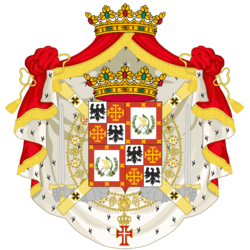
He is a member of the wealthy, powerful, and influential Cabañeras Family which had been an important military family since the Creeperian Crusade, and especially since the 1780s, when Augusto Cabañeras Arámburu, Cabañeras Gutiérrez's great great great great great grandfather, became Caudillo of Creeperopolis and supported Emperor Salvador III during the War of the Creeperian Succession. Similar to Cabañeras Gutiérrez, his great great great great grandfather, Miguel Cabañeras Gutiérrez, overthrew a reigning monarch, then Emperor Manuel IV, in favor of another, Adolfo III, in what has since become known as the Revolution of 1833. Despite his family's important historical significance, he does have a direct lineage to a Deltinian woman via Roberto Cabañeras al-Madin, who was the illegitimate and later adopted son of Alfonso Cabañeras Melléndez and a Deltinian woman who was raped during the Siege of Almadinat Almuqadasa in June 1326. Cabañeras Gutiérrez does not acknowledge his Deltinian heritage and instead considers himself as a pure Creeperian.
Cabañeras Gutiérrez has a younger bother, José Cabañeras Gutiérrez, who was born in 1961 also served in the Creeperian Army from 1979 to 1985, attended the Antonio José Sáenz y Heredia University in San Romero, and is currently a politician and the Mayor of Arcatao, San Romero. He also has a younger sister, Pamela Cabañeras Gutiérrez, who was born in 1966, attended the Antonio José Sáenz y Heredia University in San Romero, and is currently a politician and the Mayor of Potonico. When he was born, Cabañeras Gutiérrez was the grandson of Alfonso Cabañeras Moreno, the then incumbent Minister of Defense, and Selena Videla Sáenz. Through Videla Sáenz, Cabañeras Gutiérrez can trace a lineage to Miguel Sáenz Orbaneja, who was the father of Antonio Sáenz Heredia, the four-time Prime Minister of Creeperopolis and a very important Creeperian politician of the Second Parliamentary Era, Creeperian Civil War, and post-civil war period. Cabañeras Gutiérrez relates to Sáenz Orbaneja via Sáenz Heredia's younger sister, Rubí Sáenz Heredia, making Sáenz Heredia Cabañeras Gutiérrez's great uncle. Cabañeras Gutiérrez was also the nephew of Adolfo Cabañeras Moreno, who also served as Minister of Defense prior to his younger brother, although, he was assassinated 15 years before Cabañeras Gutiérrez was born, and María Azaña Negrín.
Marriage and children
Cabañeras Gutiérrez married Lucía Alonzo Moreno on 30 January 1983 in Old San Salvador, San Salvador. The couple has two children: Augusto Cabañeras Alonzo (born 17 March 1984), a Colonel in command of the 13th Infantry Division, and Adolfo Cabañeras Alonzo (born 3 April 1986), a retired Colonel who was in command of the 17th Infantry Division, who is currently a businessman with investments in the National Coffee and Sugar Corporation. Cabañeras Gutiérrez has three grandchildren, Felipe Cabañeras Hidalgo (born 2011) and Lucía Cabañeras Hidalgo (born 2014) from his eldest son, and Gustavo Cabañeras Freixa (born 2013) from his youngest son.
Lucía Alonzo Moreno
(born 1960)Augusto Cabañeras Alonzo
(born 1984)Adolfo Cabañeras Alonzo
(born 1986)
Sports
Cabañeras Gutiérrez has self-reported that he spent time playing football with his children when they were young and still plays football on his free time. He has stated that his favorite Creeperian football team is CF San Romero and that he is a fan of the Creeperopolis national football team. He was in attendance at the team's victories in the Copa Creeperiano in both 2020 and 2021. He is also a fan of the Romerists of the Antonio José Sáenz y Heredia University.
Wealth

Cabañeras Gutiérrez has a net worth of an estimated ₡400 billion colóns,[note 1] making him one of the wealthiest individuals in Creeperopolis. His family owns the Cabañeras Estate, a large mansion and estate on a 15 acre plot in the northern San Romero district of Blancaza, the wealthiest part of the city. The Cabañeras Estate is valued at an estimated ₡240 million colóns,[note 12] one of the most expensive properties in Creeperopolis. The estate is the largest and most expensive non-government owned private property which serves as a residence in Creeperopolis, being even larger than some government owned estates and palaces. His family also de facto owns the Estate of the Minister of Defense in San Salvador as the Cabañeras Family has been its only occupant since the estate's construction in 1856.
Political views
| Part of a series on |
| Romerism |
|---|
 |
| Categories: |
Cabañeras Gutiérrez has stated that he admired the ideologies, works, and beliefs of Sáenz Heredia, Adolfo III, Romero I, Ramón Serrano Suñer, and Miguel Unamuno Jugo, stating that he has formed his own personal beliefs and ideologies after theirs. He has previously praised the policies and ideologies of the right-wing to far-right Catholic Royalist Party (PRC) of the Second Parliamentary Era and has commended the actions of the Falange Creeperiano, the paramilitary wing of the Catholic Royalist Party. He labels himself as a follower of Romerism, the official ideology of the Creeperian Initiative. Some political scientists have coined his set of political beliefs as Cabañerismo or Cabañerism.
He has accepted and embraced the label of Romerism, stating that it is the only proper and functional form of government. He has self-described himself as a Falangist–Romerist, a Romerist who follows the ideology and influence of Sáenz Heredia and the Catholic Royalist Party. He is also a proponent of National Catholicism and Catholic nationalism. He supports most right-wing organizations, with notable exceptions of the Norental-Esclaveta-Pescante-Orisla-Colón Front (Frente NEPOC, which attempted to assassinate him in 1984, and the National Progressive Party (PPF), the ruling political party of Terranihil. In regards to left-wing politics, he has denounced it entirely, especially communism, socialism, and anarchism, stating:
Leftism is a disease on this world which rots the insides of nations from the core. We have shown how leftism has corrupted Creeperopolis through the De-Catholization genocide of 12 million people during the 1930s and 1940s, and how terrorist organizations like the Atheist Red Army and Militarist Front for National Liberation which terrorize civilians. Leftism has turned other nations away from God, legalizing crimes against humanity and crimes against God such as homosexuality and abortion, and allowing the worship of Baphomet.[note 13] Communism, socialism, and anarchism are the worst forms of government possible as they have no regard for the well-being of the people or the absolute and unquestionable authority of the Lord God. Such governments are destined to fail.
— Augusto Cabañeras Gutiérrez, 18 November 2012
He has also stated his disdain for democracy:
Democracy is a fool's dream and the greatest hoax to ever be conceived by humanity. It is one of the weakest and least efficient system of government possible, on the same par as communism, socialism, and anarchism. Democracy has caused so many problems, and let the Crisis of 1928 serve as such an example of the types of problems the institution of democracy can bring to a nation. Democracy is like a Chupabaca-like abomination of a political system: it sucks out the life of a nation and leaves a lifeless carcass behind, fertile breeding ground for anarchy and violence.
— Augusto Cabañeras Gutiérrez, 29 May 2014
Cabañeras Gutiérrez has been negatively portrayed as a Romerist, autocrat, totalitarian dictator, theocrat, and tyrant.[8]
Religious beliefs

Cabañeras Gutiérrez is a devout Creeperian Catholic and reportedly attends church services at the Cathedral of Christ the King weekly with his wife whenever they are in San Salvador or at the Cathedral of San Emperador Romero I in San Romero. He has also stated that he attends Easter and Christmas services in San Pedro's Basilica in San Salvador del Oeste. He has stated that he considers Jesús Cristo to be the most important figure in history and that everything that has occurred since His ministry in the Romanyan Empire in the 1st century have been affected by Him in one way or another.
He has stated that he believes that a Creeperian Catholic theocracy is essential to keep Creeperopolis "functional" and he has implemented several laws and pushed laws through the Creeperian legislatures to achieve a theocracy in Creeperopolis. He has promoted intolerance of Muslims, Protestants, and Atheists in Creeperopolis. Practicing Islam and Practicing Atheism are even completely illegal and are punishable by death.[9][10]
Cabañeras Gutiérrez has stated that Emperor Saint Romero I and King Saint Miguel I are his patron saints.
Public image
Domestic and international support
Because of the nature of censorship in Creeperopolis, practically all news media outlets in Creeperopolis universally support Cabañeras Gutiérrez's government, either out of genuine support for his government or out of fear of government retaliation for negative press reporting.
Domestic and international opposition and criticism
Controversies
Corruption
Cabañeras Gutiérrez has been considered by many independent journalists as one of the most corrupt politicians in Creeperopolis.[11] Many have considered his ₡400 billion colón[note 1] net worth to be composed of stolen, embezzled, illegal, and laundered money, all amassed to build his own personal wealth at the cost as the people of Creeperopolis, and even sometimes at the cost of the Creeperian government itself. As such, his government has been labeled as a kleptocracy.
Human rights violations
Cabañeras Gutiérrez has been heavily criticized for the human rights record of Creeperopolis, especially since he has become Minister of Defense of Creeperopolis in 2002. Several human rights organizations have cited several human rights violations and human rights abuses which have occurred during his term as Minister of Defense which have been directly committed by the Creeperian government and the Creeperian Armed Forces.
War crimes
Alleged connections to death squads and paramilitaries
Purges of political opponents
From 2003 to 2004, an estimated 10,000 to 20,000 people were arrested, imprisoned, tortured, disappeared, and/or executed by the Creeperian government. Those who were purged from their government positions had willingly aligned themselves with Alfonso VI's government and were supporters of his government. Others who were arrested included corporate businessmen and military officers. Many of those arrested were disappeared and have not been released or declared dead. The Creeperian government has refused to comment on anything regarding the purges and no one has been prosecuted for any crimes committed during the purges.
In popular culture
Depictions in film, music, and literature
- Film
- Cabañeras Gutiérrez is played by actor Martín Fuentes Huerta in the 2011 television show Ya Biene'l Tiempo.
- Cabañeras Gutiérrez is played by actor José Casanova Santiagel in Carlos López Yagüe's 2013 movie 2003.
- Cabañeras Gutiérrez is played by actor Alexander Harrido Guerrero in the 2019 movie 18-J.
- Cabañeras Gutiérrez is played by actor Óscar Tejón Castellanos in the 2020 movie Honor más de Gloria.
- Music
- The military song Alborada (Dawn in Creeperian) makes reference to Cabañeras Gutiérrez.
- The military song Mi General, Cabañeras Gutiérrez (My General, Cabañeras Gutiérrez in Creeperian) is an homage to and corrido of Cabañeras Gutiérrez.
- Literature
- A brief biography of Cabañeras Gutiérrez is presented in Orlando Pareja Palau's 2013 book El Autogolpe de 2003.
- The history of the Cabañeras Family and a biography of Cabañeras Gutiérrez is present in the 2015 book Cabañeras.
Military units named after Cabañeras Gutiérrez
- The 1st Infantry Battalion has been nicknamed la'Batallón de Cabañeras Gutiérrez (The Battalion of Cabañeras Gutiérrez) due to it being his first command in the Creeperian Army.
- A militia of the Free Creeperian Army-in-exile was named the Frente Anticabañeras (Anti-Cabañeras Front) to show its opposition to his government.[note 14]
- An elite squadron of the Militarist Nationalist Front (FRENAMI) is traditionally named after the incumbent Minister of Defense, and on 19 October 2002, the squadron was renamed from the Escuadrón Cabañeras Videla to the Escuadrón Cabañeras Gutiérrez.
Works
- Cabañeras Gutiérrez, Augusto – Promise, Progress, Prosperity, and Peace (Promesas, Progreso, Prosperidad, y Paz), San Salvador, San Salvador (5 December 2020)[7] (Text and Transcript)
Rank history
| ADL: 1 January 1977 – 1 January 1978 | |
| ALF: 1 January 1978 – 1 January 1979 | |
| MIG: 1 January 1979 – 1 January 1980 | |
| ROM: 1 January 1980 – 15 September 1980 | |
| Brigadier: 15 September 1980 – 16 October 1983 | |
| Commander of the | |
| Lieutenant General: 16 October 1983 – 9 March 1993 | |
| Commander of the | |
| General: 9 March 1993 – 1 January 1998 | |
| Commander of the | |
| Field Marshal: 1 January 1998 – 19 October 2002 | |
| Commander of the | |
| Supreme Caudillo: 19 October 2002 – present | |
| Commander of the | |
| Commander of the | |
Awards and decorations
Domestic awards and decorations
 Grand Cross of the Imperial Cross of San Romero the Martyr (x2) (15 September 2003, 4 March 2020)[12]
Grand Cross of the Imperial Cross of San Romero the Martyr (x2) (15 September 2003, 4 March 2020)[12] Grand Collar of the Imperial Order of Miguel the Great (19 October 2002)
Grand Collar of the Imperial Order of Miguel the Great (19 October 2002) Grand Collar of the Imperial Cross of Alfonso the Great (1 January 1998)
Grand Collar of the Imperial Cross of Alfonso the Great (1 January 1998) Grand Collar of the Imperial Order of Romerism (x4) (15 September 1999, 15 September 2003, 15 September 2013, 15 September 2020)
Grand Collar of the Imperial Order of Romerism (x4) (15 September 1999, 15 September 2003, 15 September 2013, 15 September 2020) Grand Collar of the Imperial Order of Adolfo the Great (9 March 1993)
Grand Collar of the Imperial Order of Adolfo the Great (9 March 1993) Grand Collar of the Imperial Order of Manuel the Great (18 August 1978)
Grand Collar of the Imperial Order of Manuel the Great (18 August 1978) Grand Collar of the Imperial Order of Felipe the Saint (15 September 1981)
Grand Collar of the Imperial Order of Felipe the Saint (15 September 1981) Grand Collar of the Imperial Order of the Cross of Fidel the Martyr (15 February 1981)
Grand Collar of the Imperial Order of the Cross of Fidel the Martyr (15 February 1981) Grand Collar of the Imperial Order of Valor and Bravery (15 September 2003)
Grand Collar of the Imperial Order of Valor and Bravery (15 September 2003) Grand Collar of the Imperial Order of the Cross of Carlos the Martyr (15 September 2003)
Grand Collar of the Imperial Order of the Cross of Carlos the Martyr (15 September 2003) Grand Collar of the Imperial Order of Grand Merit (15 September 2003)
Grand Collar of the Imperial Order of Grand Merit (15 September 2003) Grand Collar of the Imperial Order of Merit (15 September 2003)
Grand Collar of the Imperial Order of Merit (15 September 2003) 1st Class Member of the Cross of Saint Romero I (15 September 2004)
1st Class Member of the Cross of Saint Romero I (15 September 2004) 2nd Class Member of the Cross of Saint Romero I (15 September 1985)
2nd Class Member of the Cross of Saint Romero I (15 September 1985) Grand Collar of the Order of the Crusaders' Cross (15 September 2003)
Grand Collar of the Order of the Crusaders' Cross (15 September 2003) Grand Officer of the Star of the Imperial Army (x9) (1 January 1998, 15 September 2003, 15 September 2004, 8 December 2007, 30 June 2013, 15 September 2015, 4 March 2016, 17 August 2017, 4 March 2020)[12]
Grand Officer of the Star of the Imperial Army (x9) (1 January 1998, 15 September 2003, 15 September 2004, 8 December 2007, 30 June 2013, 15 September 2015, 4 March 2016, 17 August 2017, 4 March 2020)[12] Grand Collar of the Order of Santiago Matadeltinianos (15 September 1999)
Grand Collar of the Order of Santiago Matadeltinianos (15 September 1999) Grand Collar of the Order of José Delgado León (16 July 1985)
Grand Collar of the Order of José Delgado León (16 July 1985) Grand Collar of the Order of the Star of the White Rose (16 December 1993)
Grand Collar of the Order of the Star of the White Rose (16 December 1993) Grand Collar of the Order of the Golden Star's Cross (16 December 1993)
Grand Collar of the Order of the Golden Star's Cross (16 December 1993)Grand Officer of the Cross of Adolfo I (16 May 1985)
 Grand Officer of the Cross of Salvador III (29 July 1996)
Grand Officer of the Cross of Salvador III (29 July 1996) Grand Collar of the Order of the Creeperian Initiative (13 February 1977)
Grand Collar of the Order of the Creeperian Initiative (13 February 1977) 1st Class Member of the Mara Campaign Medal (1 January 1980)
1st Class Member of the Mara Campaign Medal (1 January 1980) 1st Class Member of the Deltinian Campaign Medal (1 January 2020)
1st Class Member of the Deltinian Campaign Medal (1 January 2020) A–G Class Member of the Morovan Campaign Medal (1 February 2020)
A–G Class Member of the Morovan Campaign Medal (1 February 2020) 1st Class Member of the Sequoyan Campaign Medal (1 January 2021)
1st Class Member of the Sequoyan Campaign Medal (1 January 2021) 1st Class Member of the San Carlosan Campaign Medal (1 January 1985)
1st Class Member of the San Carlosan Campaign Medal (1 January 1985) 1st Class Member of the Senvarian Campaign Medal (1 January 1978)
1st Class Member of the Senvarian Campaign Medal (1 January 1978) 1st Class Member of the Castillianan Campaign Medal (1 January 1981)
1st Class Member of the Castillianan Campaign Medal (1 January 1981) 1st Class Member of the Campaign Medal (x8) (1 January 1978, 1 January 1980, 1 January 1981, 1 January 1985, 1 January 2020, 1 February 2020, 1 July 2020, 1 January 2021)
1st Class Member of the Campaign Medal (x8) (1 January 1978, 1 January 1980, 1 January 1981, 1 January 1985, 1 January 2020, 1 February 2020, 1 July 2020, 1 January 2021) Member of the Creeperian Army Distinguished Service Badge (15 September 2004)
Member of the Creeperian Army Distinguished Service Badge (15 September 2004)
Foreign awards and decorations
 Grand Master of the Order of Service to the Fatherland (18 February 2007)
Grand Master of the Order of Service to the Fatherland (18 February 2007)
 1st Class Member of the Order of Merit of The Greater Republic of New Gandor (25 June 2005)
1st Class Member of the Order of Merit of The Greater Republic of New Gandor (25 June 2005)
 Knight of the Order of the Crown of Salisford (5 August 2008)
Knight of the Order of the Crown of Salisford (5 August 2008)
 Knight of the Supreme Order of Christ (15 September 2003)
Knight of the Supreme Order of Christ (15 September 2003) Grand Cross of the Order of the Papal Star (19 October 2002)
Grand Cross of the Order of the Papal Star (19 October 2002) Grand Cross of the Order of the Sacred Cross (25 December 2013)
Grand Cross of the Order of the Sacred Cross (25 December 2013)
Private foreign awards
Battle record
| Date | War | Action | Opponent/s | Type | Rank | Outcome |
|---|---|---|---|---|---|---|
| 15 February 1981 | Castillianan Insurgency | Battle of Gueratesón | FMLN | Battle | Brigadier | Victory |
| 14 February 1984 | Mara War | Assassination of José Renovado Tallés | MS | Raid | Lieutenant General | Victory |
| 4 February 1985 | Mara War | Pupusa Riot | MS and Rioters | Suppression | Lieutenant General | Victory |
| June 1985 – March 1987 | San Carlos Islands Crisis | Anti-insurgent operations | CR–JHPM, Frente NEPOC, MRKA | Campaign | Lieutenant General | Victory |
| 12 May 1989 | Third Senvarian Insurgency | Battle of Aalen | SKBF | Battle | Lieutenant General | Victory |
| 18 June 2003 | Creeperian Conflicts | 2003 Creeperian coup d'état | Imperial Guard | Coup d'état | Supreme Caudillo | Victory |
Football career statistics
| Club | Season | League | Postseason | Total | |||||
|---|---|---|---|---|---|---|---|---|---|
| Division | Apps | Goals | Apps | Goals | Apps | Goals | |||
| Primary school | |||||||||
| E Romero I School for Boys | Romeristos | 1968 | San Romero Primary I | 8 | 6 | 2 | 2 | 10 | 8 |
| E Romero I School for Boys | Romeristos | 1969 | San Romero Primary I | 8 | 7 | 1 | 0 | 9 | 7 |
| E Romero I School for Boys | Romeristos | 1970 | San Romero Primary I | 8 | 5 | – | 8 | 5 | |
| E Romero I School for Boys | Romeristos | 1971 | San Romero Primary I | 8 | 9 | 3 | 4 | 11 | 13 |
| E Romero I School for Boys | Romeristos | 1972 | San Romero Primary I | 8 | 5 | 2 | 0 | 10 | 5 |
| Secondary school | |||||||||
| DP José Delgado León School | Delgados | 1973 | San Romero Secondary I | 12 | 14 | 3 | 5 | 15 | 19 |
| DP José Delgado León School | Delgados | 1974 | San Romero Secondary I | 12 | 10 | 3 | 2 | 15 | 12 |
| DP José Delgado León School | Delgados | 1975 | San Romero Secondary I | 12 | 8 | 2 | 3 | 14 | 11 |
| DP José Delgado León School | Delgados | 1976 | San Romero Secondary I | 12 | 10 | 1 | 0 | 13 | 10 |
| College | |||||||||
| SS Military Academy | Soldados Militares | 1977 | Creeperian National College Football Association | 28 | 8 | – | 28 | 8 | |
| SS Military Academy | Soldados Militares | 1978 | Creeperian National College Football Association | 28 | 9 | 2 | 3 | 30 | 12 |
| SS Military Academy | Soldados Militares | 1979 | Creeperian National College Football Association | 28 | 11 | 3 | 3 | 31 | 14 |
| SS Military Academy | Soldados Militares | 1980 | Creeperian National College Football Association | 28 | 11 | 1 | 1 | 29 | 12 |
Heraldry
| Heraldry of Augusto Ramón Cabañeras y Gutiérrez | ||||||||||||||||||||||||||||||||||||||||
|---|---|---|---|---|---|---|---|---|---|---|---|---|---|---|---|---|---|---|---|---|---|---|---|---|---|---|---|---|---|---|---|---|---|---|---|---|---|---|---|---|
| ||||||||||||||||||||||||||||||||||||||||
Ancestry
| Ancestors of Augusto Ramón Cabañeras y Gutiérrez | ||||||||||||||||||||||||||||||||||||||||||||||||||||||||||||||||||||||||||||||||||||||||||||||||||||||||||||||||||||||||||||||||||||||||||||||||||||||||||||||||||||||||||||||||||||||||||||||||||||||||||||||||||||||||||||||||||||||||||||||||||||||||||||||||||||||||||||||||||||||||||||||||||||||||||||||||||||||||||||||||||||||||||||||||||||||||||||||||||||||||||||||||||||||||||||||||||||||||||||||||||||||||||||||||||||||||||||||||||||||||||||||||||||||||||||||||||||||||||||||||||||||||||||||||||||||||||||||||||||||||||||||||||||||||||||||||||||||||||||||||||||||||||||||||||||||||||||||||
|---|---|---|---|---|---|---|---|---|---|---|---|---|---|---|---|---|---|---|---|---|---|---|---|---|---|---|---|---|---|---|---|---|---|---|---|---|---|---|---|---|---|---|---|---|---|---|---|---|---|---|---|---|---|---|---|---|---|---|---|---|---|---|---|---|---|---|---|---|---|---|---|---|---|---|---|---|---|---|---|---|---|---|---|---|---|---|---|---|---|---|---|---|---|---|---|---|---|---|---|---|---|---|---|---|---|---|---|---|---|---|---|---|---|---|---|---|---|---|---|---|---|---|---|---|---|---|---|---|---|---|---|---|---|---|---|---|---|---|---|---|---|---|---|---|---|---|---|---|---|---|---|---|---|---|---|---|---|---|---|---|---|---|---|---|---|---|---|---|---|---|---|---|---|---|---|---|---|---|---|---|---|---|---|---|---|---|---|---|---|---|---|---|---|---|---|---|---|---|---|---|---|---|---|---|---|---|---|---|---|---|---|---|---|---|---|---|---|---|---|---|---|---|---|---|---|---|---|---|---|---|---|---|---|---|---|---|---|---|---|---|---|---|---|---|---|---|---|---|---|---|---|---|---|---|---|---|---|---|---|---|---|---|---|---|---|---|---|---|---|---|---|---|---|---|---|---|---|---|---|---|---|---|---|---|---|---|---|---|---|---|---|---|---|---|---|---|---|---|---|---|---|---|---|---|---|---|---|---|---|---|---|---|---|---|---|---|---|---|---|---|---|---|---|---|---|---|---|---|---|---|---|---|---|---|---|---|---|---|---|---|---|---|---|---|---|---|---|---|---|---|---|---|---|---|---|---|---|---|---|---|---|---|---|---|---|---|---|---|---|---|---|---|---|---|---|---|---|---|---|---|---|---|---|---|---|---|---|---|---|---|---|---|---|---|---|---|---|---|---|---|---|---|---|---|---|---|---|---|---|---|---|---|---|---|---|---|---|---|---|---|---|---|---|---|---|---|---|---|---|---|---|---|---|---|---|---|---|---|---|---|---|---|---|---|---|---|---|---|---|---|---|---|---|---|---|---|---|---|---|---|---|---|---|---|---|---|---|---|---|---|---|---|---|---|---|---|---|---|---|---|---|---|---|---|---|---|---|---|---|---|---|---|---|---|---|---|---|---|---|---|---|---|---|---|---|---|---|---|---|---|---|---|---|---|---|---|---|---|---|---|---|---|---|---|---|---|---|---|---|---|---|---|---|---|---|---|---|---|---|---|---|---|---|---|---|---|---|---|---|---|---|---|---|---|---|---|---|---|---|---|---|---|---|---|---|---|---|---|---|---|---|---|---|---|---|---|---|---|---|---|---|---|---|---|---|---|---|---|---|---|---|---|
| ||||||||||||||||||||||||||||||||||||||||||||||||||||||||||||||||||||||||||||||||||||||||||||||||||||||||||||||||||||||||||||||||||||||||||||||||||||||||||||||||||||||||||||||||||||||||||||||||||||||||||||||||||||||||||||||||||||||||||||||||||||||||||||||||||||||||||||||||||||||||||||||||||||||||||||||||||||||||||||||||||||||||||||||||||||||||||||||||||||||||||||||||||||||||||||||||||||||||||||||||||||||||||||||||||||||||||||||||||||||||||||||||||||||||||||||||||||||||||||||||||||||||||||||||||||||||||||||||||||||||||||||||||||||||||||||||||||||||||||||||||||||||||||||||||||||||||||||||
See also
- Óscar Benléu e Laréira – another significant military figure who gained extensive power via a coup d'état
- Maximiliér Sauléu e Dóna – another significant military figure who gained extensive power via a coup d'état
Notes
- ↑ 1.0 1.1 1.2 1.3 The equivalent of ₵50 billion Quebecshirite credits.
- ↑ Creeperian pronunciation: [awˈɣus.to ˈra.mon ka-βaˈɲeɾ.as i guˈtjeɾ.rez, ˈno.βe.no ˈdu.kwe de ka-βaˈɲeɾ.as]
- ↑ The equivalent of ₵2 trillion Quebecshirite credits.
- ↑ 4.0 4.1 The equivalent of ₵12 trillion Quebecshirite credits.
- ↑ Cabañeras Gutiérrez graduated officially ranked 1st in his class, however, some have believed that his rank was disingenuous and that he was not actually 1st in the class, but the theory is unprovable due to the secretive, nepotistic, corrupt nature of the Creeperian government.
- ↑ Named after Juan Horacio Palafox Mendoza, the 19th Capitan General of the San Carlos Islands who served from 1 March 1685 to his death on 17 September 1736.
- ↑ Named after Kapahu Alana, a Native San Carlos Islander leader and commander of the Great Revolt of Esclaveta from 2 March 1440 to his disappearance in c. late-October 1441.
- ↑ The counts of 45 Frente NEPOC, 23 CR–JHPM, and 24 MRKA executed does not include those extrajudicially executed, which is estimated to be hundreds.
- ↑ Final vote tally: 180 for, 0 abstain, 0 against.
- ↑ I don't destroy, I only serve.
- ↑ Augusto Cabañeras Gutiérrez called the regime of Alfonso VI as "Miguelist," a far-left ideology that is a form of communism formed by the National Council for Peace and Order during the Creeperian Civil War of 1933 to 1949. The ideology was formed by individuals such as Miguel VII, Cayetano Handel Carpio, Joel Lacasa Campos, and Mariano Alcocer Fraga. The government of Alfonso VI was by no means in any form Miguelist except for the fact that it was very totalitarian. The government of Alfonso VI fits more with the Romerist ideology the military junta claimed to abide by, but much more totalitarian. He likely used the term Miguelist in order to demonize his government, damage his government's credibility, and eliminate any remaining support for Alfonso VI.
- ↑ The equivalent of ₵30 million Quebecshirite credits.
- ↑ Catholics believe that Baphomet is a demon that works alongside Satan in Hell. Catholics believed that Muhammad, the founder of Islam, was the incarnation of Baphomet. As such, the Creeperian government refers to Muhammad as Baphomet, as does Creeperian academia and the Creeperian education system.
- ↑ The Anti-Cabañeras Front did not follow the traditional Creeperian naming custom of using the complete last name: Cabañeras Gutiérrez. In this context, the use of only one last name, either the paternal or maternal last name, is an insult to the person.
- ↑ Coat of arms of the Cabañeras Family.
References
Citations
- ↑ Franco Rodríguez, Carlos (21 January 2020). "Derribar del Aerolíneas de Moroba de Carga Vuelo 39 por las'Fuerzas Aerea Creeperiano" [Shootdown of Morovan Airlines Cargo Flight 39 by the Creeperian Air Force]. Gaceta Creeperiano (in Creeperian). Gaceta Creeperiano. Retrieved 17 May 2021.CS1 maint: unrecognized language (link)
- ↑ 2.0 2.1 Karamazov, Alyosha (21 January 2020). "צארן – ןאַבאָראָמ רעגירונג פּלאַנירונג ווייַטער מאַך" [Outrage – Morovan Government Planning Next Move]. Morovan People's Press (in Morovan). Morovan People's Press. Retrieved 17 May 2021.CS1 maint: unrecognized language (link)
- ↑ Cabañeras Gutiérrez, Augusto (21 January 2020). "Estatamiento del Dirección de Inteligencia Nacional enel Derribar deun Avión Morobeño" [National Intelligence Directorate Statement on the Shootdown of a Morovan Plane]. DINA.gob (in Creeperian). National Intelligence Directorate. Retrieved 17 May 2021.CS1 maint: unrecognized language (link)
- ↑ "نقاط مؤتمر عصر الزقرة" [Points of the Asr El Ziqara Conference] (in Arabic). Asr El Ziqara, Greater Sacramento. 26 January 2020. Retrieved 17 May 2021.CS1 maint: unrecognized language (link)
- ↑ "كابانيراس جوتيريز يوقع معاهدة عصر الزقرة" [Cabañeras Gutiérrez Signs the Treaty of Asr El Ziqara] (in Arabic). Asr El Ziqara, Greater Sacramento. 26 January 2020. Retrieved 17 May 2021.CS1 maint: unrecognized language (link)
- ↑ "كرامازوف يوقع معاهدة عصر الزقرة" [Karamazov Signs the Treaty of Asr El Ziqara] (in Arabic). Asr El Ziqara, Greater Sacramento. 26 January 2020. Retrieved 17 May 2021.CS1 maint: unrecognized language (link)
- ↑ 7.0 7.1 7.2 Cabañeras Gutiérrez, Augusto (5 December 2020). "Promesas, Progreso, Prosperidad, y Paz" [Promise, Progress, Prosperity, and Peace]. Mindef.gob (in Creeperian). San Salvador, Creeperopolis: Ministry of Defense of Creeperopolis. Retrieved 17 May 2021.CS1 maint: unrecognized language (link)
- ↑ Hernández Alvarado 2020, p. 3.
- ↑ Galdámez Pérez 2020, p. 1.
- ↑ Herrador Piñón 2020, p. 2.
- ↑ Hernández Alvarado 2020, p. 4.
- ↑ 12.0 12.1 Franco Rodríguez 2020, p. 1.
Bibliography
- Franco Rodríguez, Carlos (4 March 2020). "Gaceta Creeperiano – Ministro de Defensa Augusto Cabañeras Gutiérrez Decorado con Segundo Cruz Imperial de San Romero el Mártir, Primera Vez en Historia" [Gaceta Creeperiano – Minister of Defense Augusto Cabañeras Gutiérrez Decorated with Second Imperial Cross of San Romero the Martyr, First Time in History]. Gaceta Creeperiano (in Creeperian). San Salvador, Creeperopolis: Gaceta Creeperiano. pp. 1–4. Retrieved 27 April 2021.CS1 maint: unrecognized language (link)
- Galdámez Pérez, Cristóbal (2 May 2020). "Gaceta Creeperiano – El Gobierno Creeperiano Instituye Seis Nuevos Crímenes Capitales" [Gaceta Creeperiano – Creeperian Government Institutes Six New Capital Crimes]. Gaceta Creeperiano (in Creeperian). San Salvador, Creeperopolis: Gaceta Creeperiano. pp. 1–5. Retrieved 28 April 2021.CS1 maint: unrecognized language (link)
- Hernández Alvarado, Orlando (29 December 2020). "El Faro – Comentarios Finales Sobre'l Año – Edición Especial del 29 de Diciembre de 2020" [El Faro – Final Remarks on the Year – 29 December 2020 Special Edition]. El Faro (Newspaper). 2020 (in Sacramatian Spanish) (64th ed.). Barreiganca, Greater Sacramento: El Faro. 2020 (64): 1–4. Retrieved 28 April 2021.CS1 maint: unrecognized language (link)
- Herrador Piñón, Gustavo (6 September 2019). "Gaceta Creeperiano – Hombre Morobeño Condenado por'Blasfemia y Ateísmo" [Gaceta Creeperiano – Morovan Man Sentenced for Blasphemy and Atheism]. Gaceta Creeperiano (in Creeperian). San Salvador, Creeperopolis: Gaceta Creeperiano. pp. 1–3. Retrieved 28 April 2020.CS1 maint: unrecognized language (link)
Further reading
External links
- Augusto Cabañeras Gutiérrez – NSIndex – 6 October 2019
- Augusto Cabañeras Gutiérrez – IIWiki – 5 March 2020
- Pages with script errors
- CS1 maint: unrecognized language
- Articles with short description
- Use dmy dates from April 2021
- Use Jackian from February 2022
- All LCNWiki articles written in Jackian
- CS1 location test
- Pages with broken file links
- Augusto Cabañeras Gutiérrez
- 1959 births
- Creeperopolis
- Creeperopolis RP
- Creeperopolis Terraconserva
- Terraconserva
- Creeperian Conflicts
- Creeperian Military Figure
- Military officer
- 2003 Creeperian coup d'état
- San Carlos Islands
- Deltino
- Deltinian Insurgency military leader (government)
- San Carlos Islands Crisis
- 2019–2020 Morovan crisis
- Romerism
- Recipients of the Imperial Cross of San Romero the Martyr
- Recipients of the Imperial Order of Romerism




